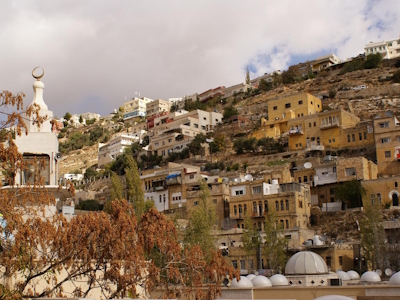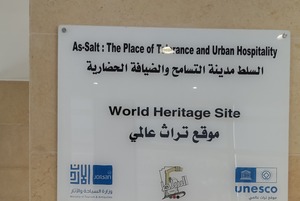As-Salt

As-Salt - The Place of Tolerance and Urban Hospitality represents the city’s ‘Golden Age’ period (1860s to 1920s).
In the late Ottoman period the town saw an influx of traders from Nablus, Syria and Lebanon and it transformed into a thriving trade city. Architecturally elegant buildings were constructed, built in a mix of Ottoman tradition and the Nablusi style with honey-coloured local stone. Both Christian and Muslim communities lived here.
Community Perspective: The best place to start is the Historical Old Salt Museum in Abu Jaber House, which is probably the most famous expression of the new architectural style. Overall, As-Salt with its parked cars and open cables certainly isn’t a photogenic city and it may be hard to understand the OUV.
Map of As-Salt
Community Reviews
Els Slots

I hadn’t planned on writing a review for this one, but I feel the need to step up for As-Salt a bit, as the current reviews are too harsh. I even believe that people posted gloomy pictures of the site on purpose! I often measure how I like a site by the number of photos I take – there were 101 here, even on a cloudy day and a Friday when many things are closed.
Sure, its OUV is debatable and the overhanging electrical wires and white water tanks have eluded the city’s beautification committee. But do we want the real world to be turned into folk villages? What I found in As-Salt is a homogenous cityscape, built against a hill and made of a distinct yellow, almost golden limestone. Many more original buildings from the late Ottoman period, when As-Salt saw its heydays, have been preserved than I had expected.
In addition to the marked spots by the tourism bureau, I liked the neighbourhood stretching east towards St. George’s Orthodox Church. It takes a bit of climbing but you will be rewarded with good views and some well-preserved traditional buildings. The area has good murals as well, including one that could go for a WH Plaque. Other good spots are the Assumption of Our Lady Catholic Church and the recently renovated residential complexes at Al Ain Square (pictured).
Logistics: I visited around lunchtime on a Friday. There’s little public transport in Amman on Friday mornings, so I took a taxi out there (10JD). On the way back, I got on a minibus that departed from the As-Salt bus terminal (0.5JD) and dropped me off in Amman's city center. It takes about 40mins.
Read more from Els Slots here.
Triath

The city itself, like everything in Jordan, is ancient, the name comes from the Latin saltus - forest.
But the real prosperity of the city took place at the turn of the 19th and 20th centuries, when the administrative regional center of the Ottoman Empire was located here, and even the independence of Transjordan was declared here in 1922 (but the center of power moved to neighboring Amman later).
In order to receive an UNESCO status, As-Salt is presented as a place of peaceful and harmonious coexistence of different religions, because in addition to the Great Mosque, there is also a Latin church, two Orthodox churches, and even an Anglican hospital. It is strongly suspected that the main motive behind the nomination by Jordan was that this city, as the first capital, has a special significance for Jordanian history.
In the tourist center, you can take a booklet with the "route of harmony", which gives at least some sense of place when exploring the city.
But I hoped that the Ottoman architecture of the "capital period" would be more interesting, it is modest actually.
In fact, it is a suburb of Amman now, so it is easy to get here by car.
Visited November 2022.
Philipp Peterer

Visit May 19. On my short trip to the northern part of Jordan I visited some great TWHS, like Jerash or Umm al-Jimal. And I visited As-Salt.
I parked my car near the town hall and went to the Archeological Museum. There I got a poorly copied map of the most important buildings related to the WHS. I spent my time hunting down these buildings.
As-Salt is certainly not a city that lets your jaw drop. What Unesco describes as “a blend of European Art Nouveau and Neo-Colonial styles combined with local traditions” were to me rather boring square buildings. The oldest part of the city is not unpleasant, but also not outstanding. Certainly it is not photogenic city. The cars, narrow streets, open cables and lack of real highlights make it hard to get some good shots. Maybe if you find a good guide that can explain the value of the city on site, you get a more satisfying visit. For me, this was absolutely no highlight in a country I otherwise quite like.
As-Salt is very close to Amman. You can easily squeeze it in on your way to the Baptism WHS.
Wojciech Fedoruk

Nowadays As-Salt is nothing more but a satellite city of Amman agglomeration. But until the First World War it was a serious rival of current Jordanian capital. It faced substantial growth particularly in the end of XIXth century, when many wealthy families from the land now called West Bank moved to As-Salt. During this time a Palestinian architect Abdel-Rahman Aqruq formed a new style calle „Arab eclecticism”. As the name suggests, the style was a mix: arabic tradition and european styles (classicism and (neo)gothic are clearly visible, so do secession elements). That style spread over the whole Middle East, which was these days united under Ottoman Empire. Given the importance of this movement, As-Salt will attempt inscription on World Heritage List in 2017.
I visited As-Salt driving from UNESCO site of Bethany beyond the Jordan to Amman. I had very limited time there and the weather was awful so the circumstances were not pleasant. Moreover, it was Friday and the Historical Old Salt Museum was closed. The museum is located in Abu Jaber House, which is probably the most famous expression of the new architectural style. Fortunately, tourist information was open and I was provided with maps proposing several different city walks, such es 'educational' or 'harmony' trail. Although they are interesting, none of them is exactly related to the potential iscription as a WHS. However, the most important buildings in the old town are supported with a plaque describing interesting facts and showing the distance to the next interesting building. Most of them are located on or near Hamman street. I imagine that if As-Salt's nomination is successful, some of these plaques will just get UNESCO sign.
Although As-Salt is quite nice and is doing its best to attract tourists, the (potential) outstanding universal value of the place is not easy to understand – I even had a problem to choose one interesting photo to illustrate my review. Even after inscription it would rather not become one the top tourist attractions in Jordan.
Community Rating
- : Ludvan Dutchnick
- : George Gdanski Stanislaw Warwas PabloNorte Hanming Fmaiolo@yahoo.com KentishTownRocks Cezar Grozavu Bin Kevin McFarland
- : Maciej Gil Alexander Lehmann Mihai Dascalu Csaba Nováczky Randi Thomsen
- : Svein Elias Lucio Gorla David Berlanda Ivan Rucek CugelVance Els Slots
- : Riccardo Quaranta Triath Wojciech Fedoruk Christravelblog Luboang
- : Thomas van der Walt Roger Ourset Frédéric M
- : Tarquinio_Superbo Philipp Peterer Alexander Parsons
Site Info
- Full Name
- As-Salt: The Place of Tolerance and Urban Hospitality
- Unesco ID
- 689
- Country
- Jordan
- Inscribed
- 2021
- Type
- Cultural
- Criteria
-
2 3
- Categories
- Urban landscape - Arabic and Middle Eastern
- Link
- By ID
Site History
2021 Inscribed
2020 Incomplete - not examined
As: As-Salt: The Place of Tolerance and Urban Hospitality
2017 Deferred
2017 Advisory Body overruled
ICOMOS suggested Not Inscribe. Overturned by amendment of Turkey to Deferral.
2015 Revision
Successor to former TWHS Old City of Salt (2004)
1994 Deferred
Bureau - require 1990 action plan to be adopted
Site Links
Unesco Website
Official Website
Related
Connections
The site has 20 connections
Art and Architecture
Constructions
History
Human Activity
Religion and Belief
Timeline
WHS Hotspots
WHS Names
World Heritage Process
Visitors
71 Community Members have visited.
The Plaque
 (photo by Riccardo Quaranta)
(photo by Riccardo Quaranta)